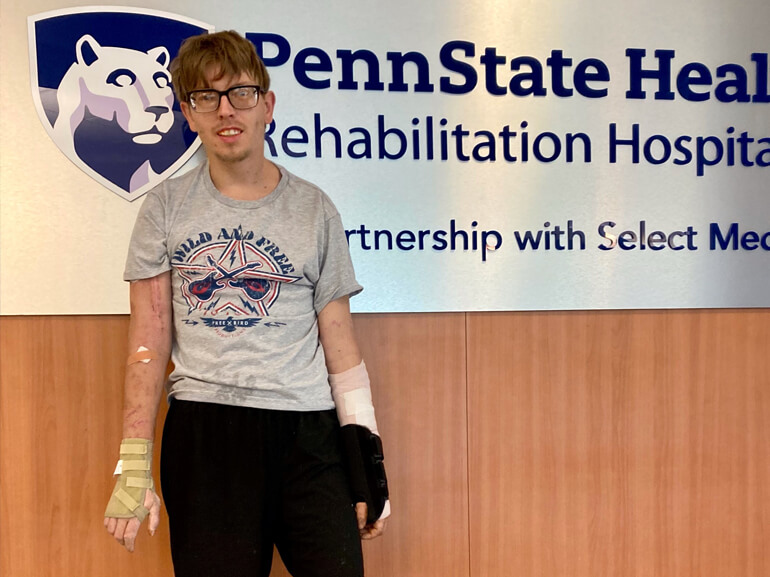Trevor's story

Trevor Rhoades, owner of a hauling service and part-time contractor, was enjoying a motorcycle ride when he was struck by another vehicle. The crash left the 28-year-old with neck and spinal cord injuries, internal bleeding and bruising and fractures to his right rib, left and right arm and left shin. Trevor was transferred by helicopter to Penn State Health Hershey Medical Center where he underwent surgery to repair his right arm and left shin.
While he made it through surgery, Trevor’s condition was complicated by pneumonia, hypertension, difficulty swallowing and weakness and loss of sensation in both of his arms resulting from injuries to his neck and spine. While the medical team had stabilized him, they let Trevor know he would need further medical care and rehabilitation. For that, he chose Penn State Health Rehabilitation Hospital.
Despite the challenges ahead, Trevor was determined to work hard on his recovery journey.
Upon admission, Trevor’s functions were limited by significant weakness in both arms and as a result, he required assistance for bathing, dressing, toileting, grooming and feeding. Trevor’s physician-led interdisciplinary team mapped out a personalized care plan for him and went to work.
Physical therapy (PT) helped Trevor rebuild his strength and agility. Strength training included working with weights and therabands. Agility exercises involved obstacle courses — stepping over items — walking across uneven surfaces and navigating steps. While Trevor was improving his abilities, he was also inspiring others. He was frequently in the therapy gym during his down time encouraging fellow patients. In a week-plus, Trevor was able to walk the hospital corridors and navigate various inclines and surfaces in the hospital courtyard ranging from grass to pavers and stones. Being able to walk longer distances both inside and outside was a great motivator for Trevor in his recovery.
Occupational therapy played an important role in addressing Trevor’s nerve injuries. His therapist applied Functional Electrical Stimulation (FES), low level electrical impulses, to his arms during exercises to stimulate his nerves, in turn moving his muscles and increasing blood flow to promote healing and movement. While the nerve damage to Trevor’s arms is projected to take years of recovery and potentially require another surgery, OT worked to increase the range of motion of his right arm, teaching Trevor how to use a long handled brush to aid in bathing.
Speech therapists sought to improve Trevor’s cognitive and language skills. The goal: sharpen his organizational and communication skills so he could eventually resume running his business. Trevor met with his therapists daily and worked on word finding, problem solving and recall exercises which helped improve his language skills, attention to detail and memory. While each task was challenging, Trevor brought a positive attitude and willingness to learn to all of his sessions, according to his therapy team.
Trevor ’s family played a pivotal role in his rehab providing support and continuously participating in training programs to assist him upon his return home. The training, they said, instilled confidence in their ability to support him physically and emotionally when he returned home.
After 10 days of inpatient rehabilitation, Trevor discharged to his grandmother’s home and was looking forward to spending time with his dog. As he reflected on his experience at Penn State Health Rehabilitation Hospital, he shared some thoughts for others who might be facing a similar challenge: “Definitely go to rehabilitation and give it all you’ve got. Stay positive. You’ve got to fight each day.”